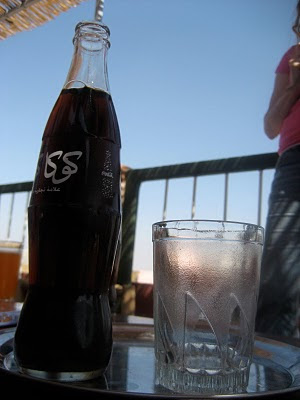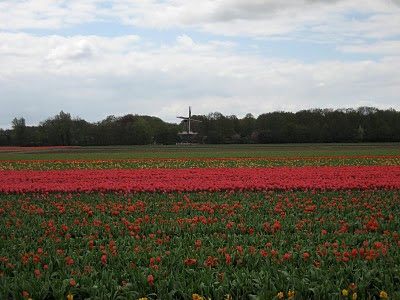
Ingredients
3-4 pound chicken, in 8 pieces -- including the neck and what innards you can tolerate
1 lemon
Salt
(Maryam says there's a tagine that's made only with offal -- but what's the most delicious-sounding term here?! Giblets? Sweetmeats? Anyway, she says it is amazing -- I have never seen it on any menu here.)
2 cups green olives, pitted, drained
Handful of cilantro, minced
Handful of parsley, minced
1/2 a preserved lemon (recipe to follow), seeds removed, rough-diced
1/2 teaspoon salt
1 scant teaspoon freshly ground black pepper
5 cloves of garlic (for a 3 pound chicken), minced
1/2 teaspoon ground ginger
1/2 teaspoon ground cumin
1/4 teaspoon cinnamon
pinch saffron threads
Here's an issue: into the fresh herb and spice marinade Maryam emptied a little sachet (maybe a teaspoon) of orange powder, a saffron-based powdered food coloring. I was thinking that to achieve both the taste and the color of saffron, you could steep the pinch of saffron threads in a little boiling water -- then add to the cooking chicken (see below, Putting it all together)... haven't yet tried this method.
1/4 cup olive oil
1 large red onion, diced
scant 1/2 cup, maybe less, sunflower oil
Water to cover the chicken for poaching (the term "poach" is probably not the correct one -- but the chicken really cooks in this last step)
Prep
Wash the chicken pieces vigorously under warm running water; stack them in a bowl.
Meanwhile, into a bowl big enough to take the chicken pieces, squeeze all the juice and pulp out of one lemon. Add maybe a tablespoon of salt, perhaps less. Add a couple cups of water, stir up, then add the chicken. Let sit to brine while you prepare the fresh herb and spice marinade.

Rinse and drain the olives; set them in a pot with water enough to cover; bring to a boil, turn down a bit, then let them simmer vigorously until most of the water has boiled away. You're left with not-so-salty, al-dente, super-tasty olives. They hold up surprisingly well under such treatment.
Fresh herb and spice marinade
In a small bowl, mix together the minced preserved lemon, minced herbs, salt, pepper, garlic and spices. (Note the spot of bright orange -- this is the powdered saffron food dye; see issue above.)
 Add the olive oil, mix again, taste, then correct for salt.
Add the olive oil, mix again, taste, then correct for salt. Remove chicken from brine and rub marinade vigorously all over each piece of chicken -- under skin, into the nooks and crannies. Set aside.

Putting it all together
Add the diced onion to a stock pot -- Maryam's method pictured here and noted below --
 then layer the slathered chicken on top, glug-glug the sunflower oil over all and set on a high fire for for 2 minutes, turning often.
then layer the slathered chicken on top, glug-glug the sunflower oil over all and set on a high fire for for 2 minutes, turning often.Turn heat down a bit, keep cooking the chicken and onions together for another 15 minutes. Turn every now and again. Marry the onions and the oil and the slathered chicken!
Now add a couple cupfuls of water, enough to put the water level just under the top layer of chicken pieces. Cook for about 20-25 minutes, or until chicken is tender. In the last 5 minutes, drain the olives (whatever of the liquid is left -- should not be much), add them to the mix so they can hang with everybody and heat through.

Transfer either to a real tagine or a dish, then serve with rounds of bread -- traditionally the way to eat it -- no forks, please, just clean fingers and hungry appreciative bellies.

On the tagine -- the actual terra cotta pot itself
I was surprised to learn that one legit method for cooking tagine is to make it in a stock pot, as Maryam did -- and serve it in the tagine. Heat your the tagine itself on the burner (top and bottom both) maybe 5 minutes, add the finished tagine; put on the conical lid, then serve, removing the lid with a flourish and a whoosh of aromatic steam.
A word on Maryam's Methods
No cutting board! Except for the fresh herbs. Garlic and onion both she held in her left hand and used the paring knife with her right, fingers flying, bits dropping into the bowl or stock pot, respectively.
Homemade Preserved Lemons
Cross-hatch a pile of lemons (two perpendicular cuts on the same end of a lemon, about 1/2 way into the fruit) -- as many lemons as will fit snugly into a large jar. Stuff salt and salt and salt into each cross-hatched lemon, then stuff them all, well packed all around with salt, into the jar. Cover and seal tightly. Put in a cool dark place FOR A YEAR.


























































